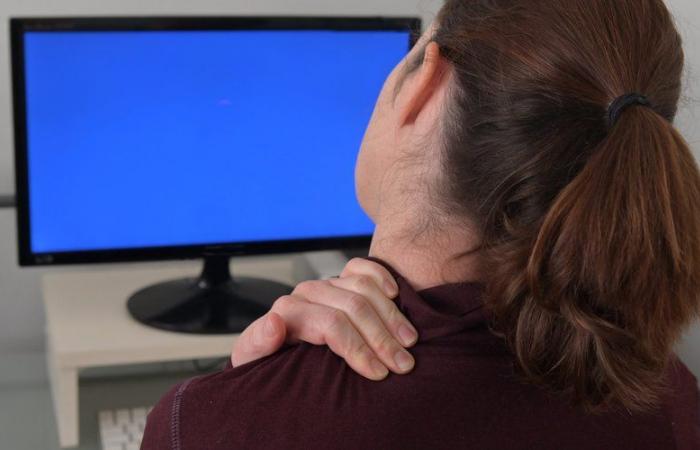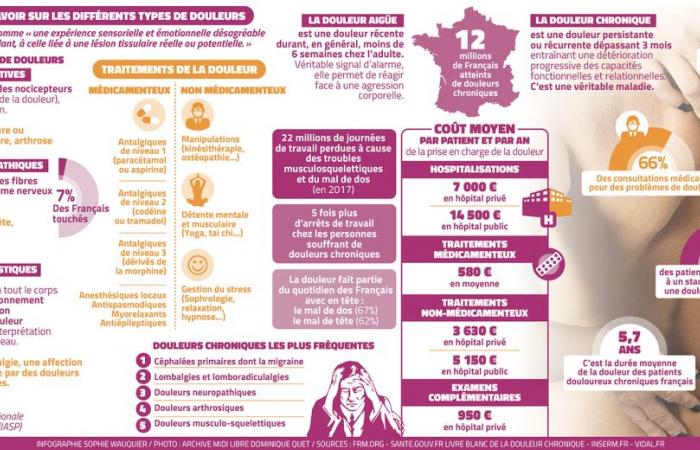Nearly one in three adults suffer from chronic pain. But this is not inevitable, explains Dr Patrick Ginies, head of the pain assessment and treatment center at Montpellier University Hospital, on the occasion of World Pain Day, October 14.
A trained resuscitation anesthetist, Dr Patrick Ginies runs a pioneering service, opened in 1979 at the Montpellier University Hospital. Chili pepper patches, connected watch, magnetic stimulation… he reminds us that current treatment is increasingly opening up to non-drug techniques.
FREE NOON
Nearly one in three French people suffer from chronic pain, are we at a turning point in treatment?
There is a new strategy, because in 70 years of research, we have made a lot of progress in understanding the mechanisms of pain, but we have no new medication.
There are many new molecules tested on animals, but when we move on to humans, we are faced with such side effects that we stop using the products. Which also raises questions about research protocols, which always start in animals.
In Montpellier, for example, we are testing today in a phase 2 trial a molecule which has had spectacular effects on animals, but we are afraid that things will not be as conclusive when we move on to humans.
In the next five years, there will be no new drugs on the market.
Today, we stick to “classic” painkillers, codeine, Tramadol, etc.
That’s it. With the particularity that from December 5, these products will be prescribed by secure prescription.
Which means?
There is always anxiety about what is happening in America with painkillers: misuse, even a health scandal. In 2023, 130,000 people will die in the United States from opioid misuse.
“Morphine misuse can make you hyperalgic, you are skinned alive”
But we are not there in France!
Not at all, in fact. But we have a few hundred, 400 or 500 accidents each year due to these painkillers.
It is this anxiety of misuse on a large scale which makes us realize that there is misuse of painkillers, misuses which are increasing. Hence the need for greater rigor in prescribing, with secure prescriptions, renewable every month.
So-called “classic” painkillers, such as Doliprane, will always be available over the counter. But weak opioids and opioids, those classified as “level 2”, will be more controlled. They will be controlled like morphine, which is a level 3 painkiller.
For what ?
Because there were excesses. For fibromyalgia, for example, people have so much pain that there has been misuse of morphine.
Did morphine still relieve the sick?
No, it has no effect. On the contrary, if poorly prescribed, morphine causes hyperalgesia! The patients are skinned alive, it’s a paradoxical effect.
Pain is not necessarily treated with chemistry…
For a long time we believed that there were only pains of the flesh, inflammations, cancers, fractures, abscesses… these pains are well controlled.
Where there has been progress is in the management of neuropathic pain, pain due to small nerve lesions, which send electrical short circuits: this is shingles, people who have had multi-operated sciatica, spinal trauma, operated breast cancer, radiation… They are exploding. And we have new strategies: local anesthetics via patches, for example.
We have a patch made from cayenne pepper. For four to five years, we have had twelve patients per day. We put a patch on for an hour, every three months. And we have significant results: by giving a “slap” to the pain circuits, we reduce pain by up to 50%. Then it often erases it, and reduces its intensity.
Midi Libre – SOPHIE WAUQUIER
The explosion of non-drug techniques
Within a well-defined framework, it is not a question of playing sorcerer’s apprentice…
Of course, with a protocol and handling instructions, the potency of this pepper is ten times greater than the hottest pepper.
This option is part of the explosion of non-drug techniques.
But that’s not all…
The other revolution is the explosion of non-drug techniques, this time in the face of chronic pain. The treatment includes therapeutic education to understand the mechanisms of pain, and the behaviors that cause pain, which make you enter this hell of chronic pain.
There is no miraculous solution, there is a collaborative approach between the patient and the medical team.
Is this psychology?
It’s more complicated. Often, psychiatrists struggle with chronic pain patients, who are confronted with the failures of all specialties: neurological, rheumatological, oncological, etc.
Anyone who has chronic pain has a little bit of social disruption, a little bit of psychological disruption, a little bit of biological disruption. We need to understand how the patient got there, how they can get out of it, and we get help with non-drug techniques. What is new is that some are validated.
What is it about?
Music therapy, with the validated Music Care technique: you choose your piece of music, and it is worked on, the music lengthens, slows down… the improvement is around 30%. Many pain centers, and thermal centers such as Lamalou and Balaruc-les-Bains, have this practice. A file has been submitted to the drug agency, it has been validated but not yet reimbursed.
We also work with so-called “millimeter” waves, on the principle of neurostimulation, for fibromyalgia, for example, and people who have poor pain control: a team from Grenoble has invented a watch, Remedee, which thus stimulates opioid control of pain. It has been validated as medical equipment. The first study was 60% positive, for chronic pain patients.
Another avenue: transcranial magnetic stimulation. The studies are starting to come out. We are finally bringing old techniques, like hypnosis, up to date.
It’s a paradigm shift, in the way doctors look. It takes a few months to get into chronic pain, but years to get out of it. The challenge is complicated. In France, 17% to 20% of the population suffers from intractable chronic pain.
“The effectiveness of cannabis is modest”
And is there any interest in cannabis?
Everyone asks us that. We finished the experiment. CBD is over the counter, anyone can try it. There is a small anxiolytic effect. THC is very little analgesic, but a little soporific, a little sedative… and a little forbidden. Canadians who have liberalized cannabis for five years have not made the expected turnover. As soon as you allow it, it loses its effectiveness…
The effectiveness in the general population is modest, it may be of interest depending on personalities and pathologies, it has proven its effectiveness when one suffers from multiple sclerosis. But it doesn’t work on fibromyalgia. And it has side effects, it causes a reduction in alertness, you can’t drive…
What advice would you give to someone suffering from chronic back pain, the “illness of the century” as they often say?
Pain often comes from a “bad adjustment”, excessive tension in all acts of daily life, day and night, years before its appearance, with people who have sometimes established rigidity in their body diagram since childhood! I’m not going to send him to the psychologist, he’ll tense up even more! And the rheumatologist is not going to question him about his initial body plan… This pain is an armor, which was put in place to protect against archaic suffering, sometimes minor, which, without this shell, could cause the core to explode. personality of the individual.
For 40 years, we searched for a faulty mechanism. But that’s not the problem… everyone has hernias, parrot’s beaks, osteoarthritis… and not everyone has pain. In this person, it will trigger twice as much pain.
In the consultation which will be carried out in the pain unit, we will try to deprogram this operation. We improve 52% of patients. But pain is a complex phenomenon, we sometimes prefer to keep it because we do not know how to express our discomfort differently.
The problem remains access to these consultations, how long do we have to wait, six months, a year?
If you call to make an appointment, there will be a long wait. You always need a letter from a doctor. People who have cancer, or a very serious illness, a severe migraine, have a consultation during the week. For intermediate situations, it will be a few months. And finally, as we are inundated with requests for fibromyalgia, it will be more like nine months.
We have trained 3,000 nurses in 40 years, doctors… But five to six million French people are “in pain”, and there are 300 full-time equivalent specialist doctors. Our discipline does not attract, we manage the failure of other disciplines, and the consequences of a stressful society.







